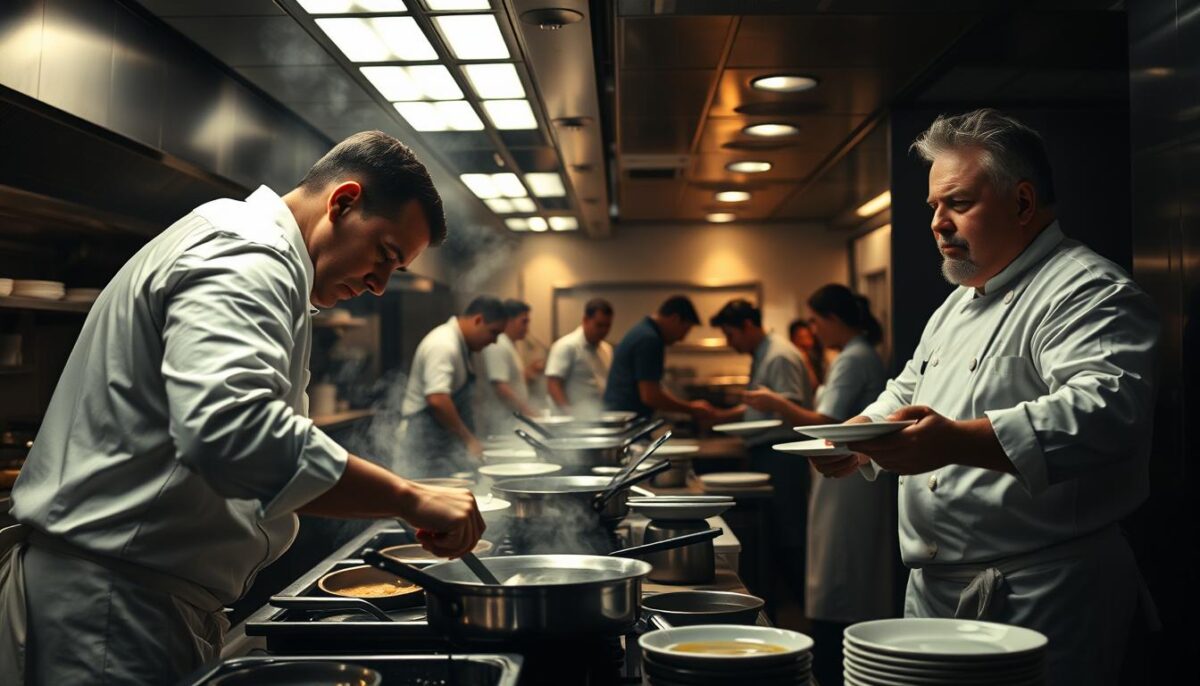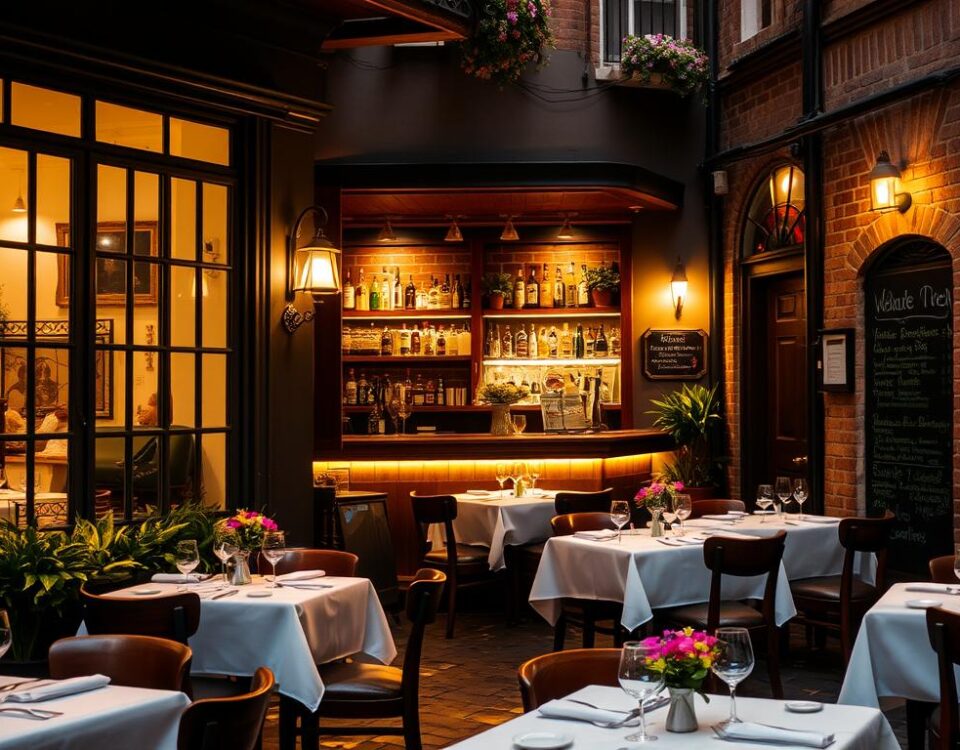
How to Optimize Google My Business and Rank #1 Locally
August 25, 2025
The Fastest Way to Boost Tripadvisor Reviews in One Month
August 26, 2025As a restaurant owner, you’ve likely experienced the frustration of watching a talented chef leave for another job, only to repeat the cycle with new hires. It’s a costly and demotivating experience that can disrupt the harmony of your kitchen.
The culinary industry is notorious for its high turnover rates, with chefs frequently switching between restaurants. In fact, a chef who stays in one kitchen for more than three years is considered a veteran. The reality is that being a chef demands an all-consuming passion, and when the challenges outweigh the rewards, even the most dedicated professionals may choose to quit their job and seek a better work-life balance.
Understanding the complex reasons chefs quit is crucial to developing effective retention strategies that don’t break the bank. So, what can restaurant owners do to keep their culinary talent happy and prevent them from leaving?
Key Takeaways
- Understand the core reasons behind chef turnover.
- Implement budget-friendly strategies to boost job satisfaction.
- Improve work-life balance for your kitchen staff.
- Create a positive and supportive kitchen environment.
- Develop effective retention strategies to reduce turnover rates.
The Hidden Cost of Chef Turnover
Understanding the hidden costs of chef turnover is crucial for restaurant owners who want to maintain a competitive edge in the industry.
Chef Turnover Rates
The rate at which chefs are leaving the industry is alarming. Studies have shown that chef turnover rates far exceed those in many other professions, with some estimates as high as 30-40% annually. This high turnover rate not only affects kitchen dynamics but also impacts the overall success of the restaurant.
Financial Impact
When a chef leaves, the costs go beyond just hiring and training a replacement. There’s menu disruption, team morale issues, and potential quality inconsistencies that directly impact the bottom line. The average cost to replace a chef can reach 30-50% of their annual salary, a significant expense that many restaurant owners underestimate.
| Cost Category | Description | Estimated Cost |
|---|---|---|
| Recruitment Costs | Advertising, interviewing, and hiring expenses | $1,000 – $3,000 |
| Training Time | Onboarding and training for the new chef | $2,000 – $5,000 |
| Lost Productivity | Reduced efficiency during the transition period | $3,000 – $6,000 |
Why Chefs Quit: Understanding the Root Causes
As a former chef, I’ve seen firsthand the pressures that drive talented individuals out of the profession. The reasons chefs quit are complex and multifaceted, involving a combination of factors that ultimately lead to their departure.
Burnout from Relentless Pressure
The kitchen environment is inherently high-stress, with the pressure to perform during peak hours being particularly intense. One mistake can ruin dozens of dishes and disappoint paying customers, creating a perfect storm for burnout. Imagine working in an environment where the stakes are high, and the margin for error is low.

Grueling Hours and No Work-Life Balance
Many chefs work 12-14 hour days, often for 10 or more consecutive days without a break, making it challenging to maintain relationships or pursue interests outside the kitchen. The grueling schedule means chefs miss important life events and family gatherings, creating a sense of isolation that builds over time.
Inadequate Compensation for Skill Level
Despite the high skill level required, chef compensation often falls below other professions requiring similar training and expertise. The proportion between work versus reward is inexplicable – it takes years to become a great chef, yet the financial compensation rarely matches the investment of time and energy.
Toxic Kitchen Culture and Management
Toxic kitchen culture, including verbal abuse, hazing, and the “Gordon Ramsay-style criticism” that’s glorified on TV, creates hostile work environments that talented chefs eventually refuse to tolerate. Many chefs report that management issues, including poor communication, lack of respect, and unrealistic expectations, ultimately push them to seek employment elsewhere.
| Factor | Impact on Chefs | Potential Solution |
|---|---|---|
| Relentless Pressure | Burnout, stress | Implement stress management training |
| Grueling Hours | Fatigue, lack of work-life balance | Introduce flexible scheduling |
| Inadequate Compensation | Frustration, demotivation | Review and adjust compensation packages |
| Toxic Kitchen Culture | Hostile work environment, turnover | Foster a positive, respectful culture |
Creating a Supportive Kitchen Environment
Creating a supportive kitchen environment is crucial for retaining top culinary talent. A kitchen where chefs feel valued and supported can significantly impact their job satisfaction and overall well-being.
Rethinking Kitchen Hierarchy
The traditional brigade system has its merits, but it’s essential to consider how modifications to kitchen hierarchy can create more collaborative environments. By rethinking the traditional structure, kitchens can become more efficient and foster a sense of teamwork among staff. For instance, some restaurants have implemented a more flat organizational structure, allowing for more direct communication between chefs and management.
Constructive Feedback vs. Gordon Ramsay-Style Criticism
Constructive feedback is vital for growth and improvement in any kitchen. However, there’s a significant difference between helpful criticism and the abusive behavior often normalized in many kitchens. Successful restaurants have implemented feedback systems that improve performance while maintaining chef dignity and mental health. For example, some kitchens use a “feedback loop” where chefs receive constructive criticism and are also encouraged to provide feedback on their own experience.
Building Team Camaraderie Without Forced “Family Meals”
Team camaraderie is crucial in high-pressure kitchen environments. However, forced “family meals” and after-hours bonding can contribute to burnout by extending already long workdays. Instead, kitchens can foster genuine team connections through thoughtful approaches that respect boundaries and personal time. For instance, some restaurants organize team-building activities outside of work hours, such as volunteer days or social events, to promote a sense of belonging without adding to the workload.
By implementing these strategies, kitchens can create a supportive environment that attracts and retains top culinary talent. Chefs who feel respected and supported are more likely to weather the stresses of a busy kitchen without reaching their breaking point.
Work-Life Balance Solutions That Don’t Break the Bank
By implementing a few simple changes, restaurants can help their chefs achieve a better work-life balance without breaking the bank. The traditional chef schedule of working long hours, nights, and weekends is a primary reason talented chefs leave the industry. However, there are creative alternatives that don’t require hiring additional staff.
Innovative Scheduling Approaches
Restaurants are finding innovative ways to schedule their staff that improve work-life balance. For instance, split shifts allow chefs to have a break during the day and return for the evening service. Some establishments are adopting four-day workweeks, ensuring that chefs have an extra day off to recharge. Rotating weekend schedules can also help distribute the workload more evenly, giving chefs more predictable time off.
Preventing Burnout Through Rotation
Preventing burnout is crucial for maintaining a happy and healthy kitchen staff. One effective strategy is rotating responsibilities among chefs. This not only keeps the job interesting but also ensures that chefs are continually learning and developing new skills. By varying tasks, chefs are less likely to feel stagnant or bored, reducing the likelihood of burnout.
Time-Off Policies That Actually Work
Having effective time-off policies in place is vital for maintaining a good work-life balance. Restaurants can implement policies that respect scheduled days off, a zero-cost retention strategy that significantly improves chef satisfaction and loyalty. Cross-training staff creates flexibility in scheduling, benefiting both the restaurant and individual chefs by allowing for more predictable time off without disrupting service.
Predictability in scheduling is often more important to chefs than the total hours worked. Knowing when they’ll be off allows them to plan their personal lives and maintain relationships outside of work. By auditing current scheduling practices and implementing improvements, restaurants can significantly enhance the work-life balance of their chefs.
Professional Growth on a Shoestring Budget
Fostering professional growth in your kitchen doesn’t have to break the bank. Many chefs leave their jobs due to a lack of opportunities for advancement. However, creating a learning environment can be achieved through simple, cost-effective measures.

Learning Opportunities in the Kitchen
One way to encourage growth is by rotating chefs through different stations. This not only broadens their skill set but also helps in identifying areas where they excel. Internal skill-sharing sessions can also be a valuable tool, allowing chefs to learn from each other’s strengths.
For instance, implementing “R&D days” where chefs can experiment with new techniques and ingredients can be highly motivating. This approach not only fosters creativity but also keeps the menu fresh and exciting for customers.
Benefits of Cross-Training
Cross-training is another effective strategy that benefits both the restaurant and the individual chefs. It creates operational flexibility and enhances work-life balance by distributing tasks more evenly among the team.
| Cross-Training Benefits | For the Restaurant | For the Chefs |
|---|---|---|
| Operational Flexibility | Increased efficiency during peak hours | Reduced stress and burnout |
| Skill Development | Better coverage during staff shortages | Enhanced career prospects |
Encouraging Creativity on a Budget
There are several low-cost ways to encourage creativity among your chefs. Implementing chef’s specials programs allows them to showcase their skills and creativity. Collaborative menu development processes also foster a sense of ownership and teamwork.
Establishing relationships with local farmers for unique ingredients can further inspire creativity without incurring significant expenses. These approaches not only keep your menu dynamic but also provide your chefs with a sense of accomplishment and growth.
Recognition and Rewards That Matter More Than Money
While salary is important, it’s not the only factor that determines whether a chef will stay or leave. In fact, many chefs report that respect and professional development opportunities matter more than marginal pay increases when deciding whether to stay or leave a job. This is where recognition and rewards come into play.

The Power of Genuine Appreciation
Genuine appreciation can go a long way in making chefs feel valued. Public acknowledgment of their contributions, whether through staff meetings or social media, can boost their morale. Involving them in business decisions and seeking their input on menu direction can also make them feel more invested in the restaurant’s success.
Career Advancement Opportunities
Career advancement opportunities don’t always mean promotions. They can include increased responsibility, such as leading a kitchen project, or representing the restaurant at culinary events. Providing opportunities for professional growth can motivate chefs to stay with the restaurant long-term.
Non-Monetary Perks Chefs Actually Value
Non-monetary perks that chefs value include flexible scheduling, creative freedom, and quality equipment to work with. Other perks, such as family meals with quality ingredients and opportunities to showcase personal specialties, can also enhance their job satisfaction.
- Flexible scheduling allows for better work-life balance.
- Creative freedom enables chefs to express their culinary creativity.
- Quality equipment ensures that chefs can perform their job efficiently.
By focusing on these aspects, restaurants can create a culture where chefs feel their work has meaning and impact beyond just preparing food for customers. This, in turn, can lead to increased job satisfaction and reduced turnover rates.
Conclusion
Retaining talented chefs doesn’t have to break the bank; it’s about creating an environment that respects their craft. Throughout this article, we’ve explored the reasons why chefs quit and how restaurant owners can implement budget-friendly retention strategies that actually work.
By addressing fundamental issues like respect, growth, and work-life balance, you can significantly improve chef satisfaction and retention rates. It’s not just about keeping bodies in the kitchen; it’s about maintaining the quality, consistency, and unique culinary voice that defines your restaurant.
Small, incremental changes in kitchen management can have dramatic effects. By recognizing the value of your chefs as professionals and human beings, you can create a kitchen where people want to stay. This approach not only improves retention but also gives your restaurant a competitive edge in the evolving culinary industry.
FAQ
What are the main reasons chefs leave their jobs?
The primary reasons chefs quit their jobs include burnout from relentless pressure, grueling hours with no work-life balance, inadequate compensation for their skill level, and a toxic kitchen culture.
How can restaurants reduce chef turnover?
Restaurants can reduce chef turnover by creating a supportive kitchen environment, offering work-life balance solutions, providing opportunities for professional growth, and showing recognition and rewards that matter to chefs.
What are some innovative ways to improve work-life balance for chefs?
Some innovative approaches include flexible scheduling, rotation to prevent burnout, and time-off policies that actually work, allowing chefs to recharge and maintain a healthy work-life balance.
How can restaurants encourage professional growth without breaking the bank?
Restaurants can encourage professional growth by creating learning opportunities in the kitchen, offering cross-training benefits, and providing low-cost ways to encourage creativity, such as experimenting with new recipes or ingredients.
What kind of recognition and rewards do chefs value?
Chefs value genuine appreciation, career advancement opportunities, and non-monetary perks such as flexible scheduling, additional time off, or opportunities to participate in culinary events and competitions.
How can kitchen hierarchy be restructured to reduce turnover?
Rethinking kitchen hierarchy involves creating a more collaborative and inclusive environment, where every team member feels valued and respected, and has opportunities to contribute to decision-making processes.



